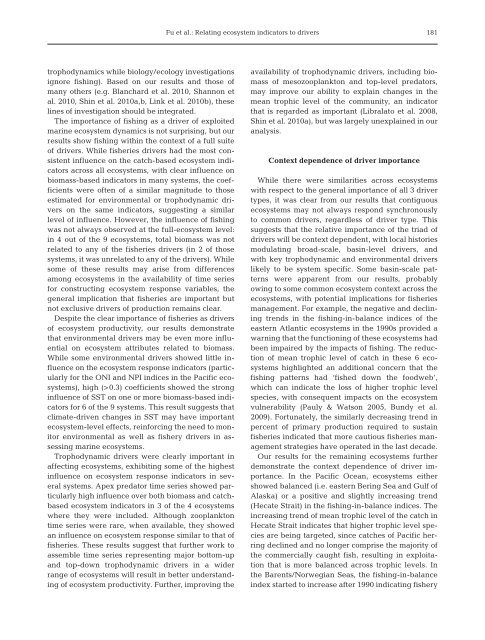Complete Theme Section in pdf format - Inter Research
Complete Theme Section in pdf format - Inter Research
Complete Theme Section in pdf format - Inter Research
Create successful ePaper yourself
Turn your PDF publications into a flip-book with our unique Google optimized e-Paper software.
Fu et al.: Relat<strong>in</strong>g ecosystem <strong>in</strong>dicators to drivers<br />
181<br />
trophodynamics while biology/ eco logy <strong>in</strong>vestigations<br />
ignore fish<strong>in</strong>g). Based on our results and those of<br />
many others (e.g. Blanchard et al. 2010, Shannon et<br />
al. 2010, Sh<strong>in</strong> et al. 2010a,b, L<strong>in</strong>k et al. 2010b), these<br />
l<strong>in</strong>es of <strong>in</strong>vestigation should be <strong>in</strong>tegrated.<br />
The importance of fish<strong>in</strong>g as a driver of exploited<br />
mar<strong>in</strong>e ecosystem dynamics is not surpris<strong>in</strong>g, but our<br />
results show fish<strong>in</strong>g with<strong>in</strong> the context of a full suite<br />
of drivers. While fisheries drivers had the most consistent<br />
<strong>in</strong>fluence on the catch-based ecosystem <strong>in</strong>dicators<br />
across all ecosystems, with clear <strong>in</strong>fluence on<br />
biomass-based <strong>in</strong>dicators <strong>in</strong> many systems, the coefficients<br />
were often of a similar magnitude to those<br />
estimated for environmental or trophodynamic drivers<br />
on the same <strong>in</strong>dicators, suggest<strong>in</strong>g a similar<br />
level of <strong>in</strong>fluence. However, the <strong>in</strong>fluence of fish<strong>in</strong>g<br />
was not always observed at the full-ecosystem level:<br />
<strong>in</strong> 4 out of the 9 ecosystems, total biomass was not<br />
related to any of the fisheries drivers (<strong>in</strong> 2 of those<br />
systems, it was unrelated to any of the drivers). While<br />
some of these results may arise from differences<br />
among ecosystems <strong>in</strong> the availability of time series<br />
for construct<strong>in</strong>g ecosystem response variables, the<br />
general implication that fisheries are important but<br />
not exclusive drivers of production rema<strong>in</strong>s clear.<br />
Despite the clear importance of fisheries as drivers<br />
of ecosystem productivity, our results demonstrate<br />
that environmental drivers may be even more <strong>in</strong>fluential<br />
on ecosystem attributes related to biomass.<br />
While some environmental drivers showed little <strong>in</strong> -<br />
fluence on the ecosystem response <strong>in</strong>dicators (particularly<br />
for the ONI and NPI <strong>in</strong>dices <strong>in</strong> the Pacific ecosystems),<br />
high (>0.3) coefficients showed the strong<br />
<strong>in</strong>fluence of SST on one or more biomass-based <strong>in</strong>dicators<br />
for 6 of the 9 systems. This result suggests that<br />
climate-driven changes <strong>in</strong> SST may have important<br />
ecosystem-level effects, re<strong>in</strong>forc<strong>in</strong>g the need to monitor<br />
environmental as well as fishery drivers <strong>in</strong> as -<br />
sess<strong>in</strong>g mar<strong>in</strong>e ecosystems.<br />
Trophodynamic drivers were clearly important <strong>in</strong><br />
affect<strong>in</strong>g ecosystems, exhibit<strong>in</strong>g some of the highest<br />
<strong>in</strong>fluence on ecosystem response <strong>in</strong>dicators <strong>in</strong> several<br />
systems. Apex predator time series showed particularly<br />
high <strong>in</strong>fluence over both biomass and catchbased<br />
ecosystem <strong>in</strong>dicators <strong>in</strong> 3 of the 4 ecosystems<br />
where they were <strong>in</strong>cluded. Although zooplankton<br />
time series were rare, when available, they showed<br />
an <strong>in</strong>fluence on ecosystem response similar to that of<br />
fisheries. These results suggest that further work to<br />
assemble time series represent<strong>in</strong>g major bottom-up<br />
and top-down trophodynamic drivers <strong>in</strong> a wider<br />
range of ecosystems will result <strong>in</strong> better understand<strong>in</strong>g<br />
of ecosystem productivity. Further, improv<strong>in</strong>g the<br />
availability of trophodynamic drivers, <strong>in</strong>clud<strong>in</strong>g biomass<br />
of mesozooplankton and top-level predators,<br />
may improve our ability to expla<strong>in</strong> changes <strong>in</strong> the<br />
mean trophic level of the community, an <strong>in</strong>dicator<br />
that is regarded as important (Libralato et al. 2008,<br />
Sh<strong>in</strong> et al. 2010a), but was largely unexpla<strong>in</strong>ed <strong>in</strong> our<br />
analysis.<br />
Context dependence of driver importance<br />
While there were similarities across ecosystems<br />
with respect to the general importance of all 3 driver<br />
types, it was clear from our results that contiguous<br />
ecosystems may not always respond synchronously<br />
to common drivers, regardless of driver type. This<br />
suggests that the relative importance of the triad of<br />
drivers will be context dependent, with local histories<br />
modulat<strong>in</strong>g broad-scale, bas<strong>in</strong>-level drivers, and<br />
with key trophodynamic and environmental drivers<br />
likely to be system specific. Some bas<strong>in</strong>-scale patterns<br />
were apparent from our results, probably<br />
ow<strong>in</strong>g to some common ecosystem context across the<br />
ecosystems, with potential implications for fisheries<br />
management. For example, the negative and decl<strong>in</strong><strong>in</strong>g<br />
trends <strong>in</strong> the fish<strong>in</strong>g-<strong>in</strong>-balance <strong>in</strong>dices of the<br />
eastern Atlantic ecosystems <strong>in</strong> the 1990s provided a<br />
warn<strong>in</strong>g that the function<strong>in</strong>g of these ecosystems had<br />
been impaired by the impacts of fish<strong>in</strong>g. The reduction<br />
of mean trophic level of catch <strong>in</strong> these 6 ecosystems<br />
highlighted an additional concern that the<br />
fish<strong>in</strong>g patterns had ‘fished down the foodweb’,<br />
which can <strong>in</strong>dicate the loss of higher trophic level<br />
species, with consequent impacts on the ecosystem<br />
vulnerability (Pauly & Watson 2005, Bundy et al.<br />
2009). Fortunately, the similarly decreas<strong>in</strong>g trend <strong>in</strong><br />
percent of primary production required to susta<strong>in</strong><br />
fisheries <strong>in</strong>dicated that more cautious fisheries management<br />
strategies have operated <strong>in</strong> the last decade.<br />
Our results for the rema<strong>in</strong><strong>in</strong>g ecosystems further<br />
de monstrate the context dependence of driver im -<br />
portance. In the Pacific Ocean, ecosystems either<br />
showed balanced (i.e. eastern Ber<strong>in</strong>g Sea and Gulf of<br />
Alaska) or a positive and slightly <strong>in</strong>creas<strong>in</strong>g trend<br />
(Hecate Strait) <strong>in</strong> the fish<strong>in</strong>g-<strong>in</strong>-balance <strong>in</strong>dices. The<br />
<strong>in</strong>creas<strong>in</strong>g trend of mean trophic level of the catch <strong>in</strong><br />
Hecate Strait <strong>in</strong>dicates that higher trophic level species<br />
are be<strong>in</strong>g targeted, s<strong>in</strong>ce catches of Pacific herr<strong>in</strong>g<br />
decl<strong>in</strong>ed and no longer comprise the majority of<br />
the commercially caught fish, result<strong>in</strong>g <strong>in</strong> exploitation<br />
that is more balanced across trophic levels. In<br />
the Barents/Norwegian Seas, the fish<strong>in</strong>g-<strong>in</strong>-balance<br />
<strong>in</strong>dex started to <strong>in</strong>crease after 1990 <strong>in</strong>dicat<strong>in</strong>g fishery
















